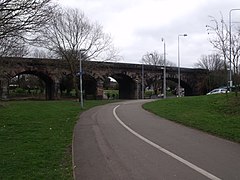
Staffordshire is a landlocked county in the West Midlands of England. It borders Cheshire to the northwest, Derbyshire and Leicestershire to the east, Warwickshire to the southeast, the West Midlands County and Worcestershire to the south, and Shropshire to the west.

Tamworth is a large market town and borough in Staffordshire, England, 14 miles (23 km) north-east of Birmingham and on the West Coast Main Line. The town adjoins Warwickshire to the south and east, Lichfield to the north and west and local junctions of the M6 Toll motorway. It takes its name from the River Tame, which flows through it. The population of Tamworth borough (mid-2019 est.) was 76,696. The wider urban area has a population of 81,964.
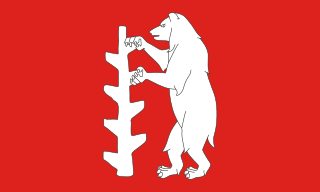
Warwickshire is a county in the West Midlands region of England. The county town is Warwick, and the largest town is Nuneaton. The county is famous for being the birthplace of William Shakespeare at Stratford-upon-Avon and Victorian novelist George Eliot,, at Nuneaton. Other significant towns include Rugby, Leamington Spa, Bedworth and Kenilworth. The county offers a mix of historic towns and large rural areas. It is a popular destination for international and domestic tourists to explore both medieval and more recent history.
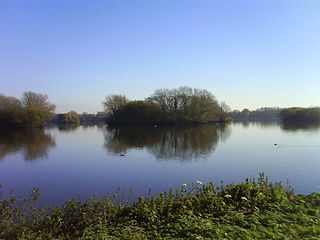
Kingsbury is a large village and civil parish in the North Warwickshire district of the county of Warwickshire, in the West Midlands region of England. The civil parish population at the 2011 census was 7,652.
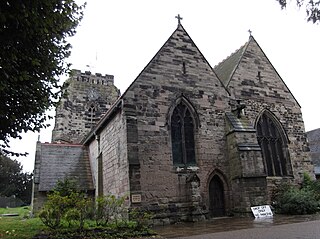
Polesworth is a large village and civil parish in the North Warwickshire district of Warwickshire, England. Polesworth is situated close to the northern tip of Warwickshire, adjacent to the border with Staffordshire, it is only 3 miles (5 km) east of the large town of Tamworth, and is 4.5 miles (7 km) north-west of Atherstone. The border with Derbyshire is 5.5 miles (9 km) to the north and the River Anker runs through the village.
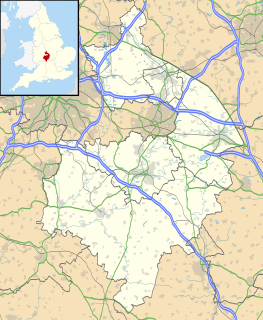
Water Orton is a village near the River Tame in the North Warwickshire borough of Warwickshire in England. It is located between Castle Bromwich and Coleshill, and borders the West Midlands metropolitan county boundary to the north, west and south. At the census in 2001, the population was 3,573, falling to 3,444 at the 2011 Census.

John Villiers Stuart Townshend, 5th Marquess Townshend, known as Viscount Raynham from 1855 to 1863, was a British peer and Liberal Member of Parliament.

Amington is a suburban village, parish and ward, in Staffordshire, England. Formerly a distinct village, it is now part of the Tamworth borough, with no gap between it and the neighbouring wards of Bolehall, Glascote, Glascote Heath and Stonydelph.
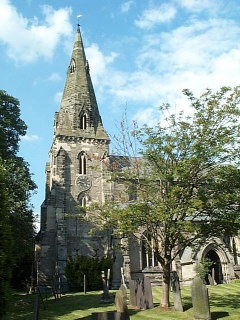
Austrey is a village and civil parish in the North Warwickshire District of Warwickshire, England. and the village lies at the northern extremity of the County.

Nether Whitacre is a small village and larger rural civil parish in North Warwickshire, Warwickshire, England.

Dosthill is an area of Tamworth, Staffordshire, 2.5 miles south of the town centre, and close to the River Tame. The area is mostly residential, centering on Dosthill High Street, with local employment on the adjoining Tame Valley Industrial Estate. The High Street includes a public house called 'The Fox' and Dosthill Primary School (photo) which dates back to 1887.
The Tamworth Herald is a weekly tabloid newspaper published every Thursday in Tamworth, Staffordshire, England, with a cover price of £1.40. The newspaper covers events across Tamworth and south Staffordshire, as well as North Warwickshire. The Herald was named ‘Newspaper of the Year’ at the Midland Media Awards in 2015 and 2016. In November 2018 the Herald celebrated its 150th anniversary with a party in the Town Hall

Astley Castle is a ruinous moated fortified 16th century manor house in North Warwickshire. It has been listed as a Grade II* listed building since 1952 and as a Scheduled Ancient Monument since 1994. It was derelict and neglected since it was severely damaged by fire in 1978 whilst in use as a hotel and was officially a Building at Risk. The building reopened as a holiday let in 2012 after extensive and novel renovations that combine modern elements within the (mostly) renaissance remains. In 2013, Astley Castle won the Royal Institute of British Architects Stirling Prize for architecture, as an "exceptional example" of the blending of an ancient monument with modern architecture.
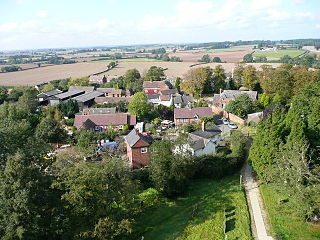
Clifton Campville is a village, former manor and civil parish in Staffordshire, England. It lies on the River Mease, about 10 miles (16 km) east of the City of Lichfield, 6 miles (10 km) west of Measham and 7 miles (11 km) north of Tamworth. The village lies very close to Staffordshire's borders with Derbyshire, Leicestershire and Warwickshire. In 2001 the parish had a population of 764, increasing to 912 at the 2011 census. In 1848 the parish included both Haunton and Harlaston, and also Chilcote in Derbyshire. Clifton itself then had a population of 341, while the population of the whole parish was 921 on 6,300 acres (25 km2). The core parish of Clifton and Haunton covered around 3,000 acres (12 km2) in 1851. Nowadays the Church of England parish still includes Haunton and Chilcote, and also Statfold. There is a fine gothic church, dedicated to St Andrew, and listed Grade I. The village pub, The Green Man, is also a historic building.

Harlaston is a village and civil parish in Staffordshire, England. It lies on the River Mease, about 5 miles (8 km) north of Tamworth. There is an Early English church, dedicated to St Matthew, and a public house, the White Lion.

Thorpe Constantine is a small village and civil parish in Staffordshire, England. It lies about 6 miles (10 km) north-east of Tamworth and 6 miles south-west of Measham. The nucleus of the parish is the Thorpe estate.

Glascote is an area of Tamworth in Staffordshire, England. The area centres on the Glascote Road, and is mainly residential with a few convenience stores and pubs.

Seckington is a village and civil parish in North Warwickshire, about 4 miles (6 km) northeast of Tamworth, Staffordshire. The B4593 road between Tamworth and Appleby Magna runs through the parish, passing about 100 yards (91 m) north of the village.

Bolehall Viaduct, known locally as The 19 Arches is a 807 feet (246 m) viaduct on the former Birmingham and Derby Junction Railway line near Tamworth, Staffordshire, England now part of the Cross Country Route.
Tamworth is a market town and borough in Staffordshire, England. It contains 138 listed buildings that are recorded in the National Heritage List for England. Of these, three are listed at Grade I, the highest of the three grades, five are at Grade II*, the middle grade, and the others are at Grade II, the lowest grade. The town includes its central area and the districts of Amington, Bolehall, Dosthill, Fazeley, Glascote, and Wilnecote. The most important buildings in the town are the Church of St Editha, and Tamworth Castle and its causeway walls, all of which are listed at Grade I. Most of the listed buildings are houses and associated structures, shops and offices, many of which originated as houses. The Coventry Canal passes through the town and makes a junction with the termination of the Birmingham and Fazeley Canal. The listed buildings associated with the canals are bridges, an aqueduct, and a milepost. The other listed buildings include churches and items in churchyards, public houses, bridges over the River Tame, other structures associated with the castle, former schools, parts of medieval walls, a farmhouse, a barn, a hotel, a former workhouse, public buildings, banks, a milestone, a railway viaduct, a bowling clubhouse, statues, one of Sir Robert Peel and the other of Ethelfleda, and a war memorial.
